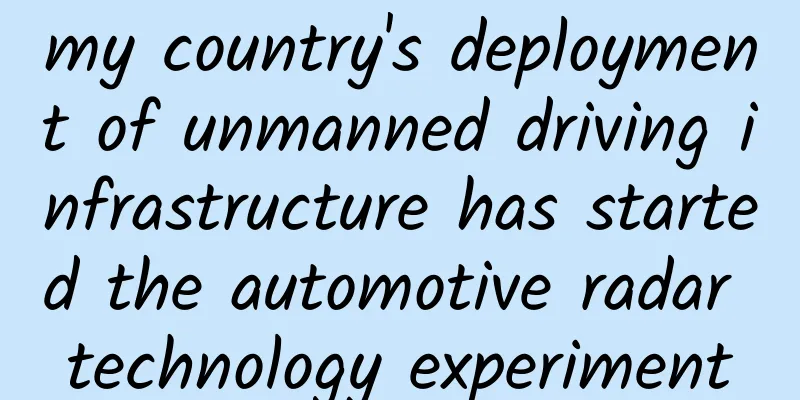my country's deployment of unmanned driving infrastructure has started the automotive radar technology experiment

|
On November 23, the reporter learned from the Automotive Information Service Industry Application Alliance that my country has launched research and testing work on 77-81GHz millimeter wave radar wireless technology and frequency division for vehicles. In addition, the Ministry of Industry and Information Technology commissioned the Automotive Information Service Industry Application Alliance (TIAA) and the China Academy of Information and Communications Technology to carry out research and testing work on LTE-V wireless technology and frequency division for intelligent transportation vehicle-to-vehicle communication based on independent intellectual property rights. All these indicate that China has begun to comprehensively deploy independent vehicle-to-vehicle communication technology based on 5G. With the industrialization and commercialization of my country's advanced communication technology, it will be beneficial to enhance China's core competitiveness in the field of smart cars and vehicle networking, support China's independent technology to become the core proposal for global frequency unification of intelligent transportation systems at the 2019 World Radiocommunication Conference (WRC-19), and promote Chinese technology to seize the cutting-edge market. 5G-based autonomous vehicle-to-vehicle communication technology is crucial for autonomous and unmanned driving. Specifically, unmanned vehicles need to "see" or "sense" the external environment through sensors before they can automatically plan driving routes and control the vehicle to reach the predetermined destination. In addition, to achieve autonomous driving and even unmanned driving, four weather conditions, simple during the day, complex during the day, simple at night, and complex at night, are required to ensure 100% reliable driving, so communication technology and other technologies are needed. Pang Chunlin, Secretary General of the In-Vehicle Information Service Industry Application Alliance (TIAA), pointed out that for smart cars and smart transportation, sensors and communication technologies are like the left and right eyes, playing different roles. At present, due to technical reasons, the "left eye" of image sensors, millimeter-wave radars, and laser radars cannot guarantee 100% recognition of targets under all-weather and all-terrain conditions. Therefore, it is necessary to rely on the "right eye" of vehicle-to-vehicle communication technology to supplement it, so that the binocular vision level can reach 1.5. As a winner of Toutiao's Qingyun Plan and Baijiahao's Bai+ Plan, the 2019 Baidu Digital Author of the Year, the Baijiahao's Most Popular Author in the Technology Field, the 2019 Sogou Technology and Culture Author, and the 2021 Baijiahao Quarterly Influential Creator, he has won many awards, including the 2013 Sohu Best Industry Media Person, the 2015 China New Media Entrepreneurship Competition Beijing Third Place, the 2015 Guangmang Experience Award, the 2015 China New Media Entrepreneurship Competition Finals Third Place, and the 2018 Baidu Dynamic Annual Powerful Celebrity. |
<<: Tesla Model 3 may be delayed until late 2018
>>: US regulators want phone makers to add driving mode, emulating airplane mode
Recommend
If "Children" is written on food packaging, does it mean it is safe and healthy?
On April 16, taking advantage of the weekend, Wen...
How to write a good copy that will not be disliked by users?
Just like posting advertising copy in the circle ...
Why is Hongmeng competing with iOS instead of Android?
Guests | Li Chuanzhao, Song Xujun Written by | Yu...
Tencent Advertising Platform Advertiser Violation Penalty Regulations!
I. Definition of advertiser violation Advertiser ...
Short video promotion: How to quickly attract users and achieve conversions?
In the era of content consumption, short videos h...
Why can't astronauts get out of the return capsule right away after returning to Earth? Why do they have to lie down after leaving the capsule?
Friends who have watched the live broadcast of th...
Apple's decline
"Is there any signal?" two Apple users ...
Users (fans) start to leave at an accelerated rate, what else can you do?
If you are extremely sensitive to user activity, ...
The rules for attracting traffic in overseas app stores!
There are three major challenges in going oversea...
How to quickly take over a new SEM project?
When it comes to online marketing, many people wi...
5 predictions for IoT and mobile app integration
It makes sense to integrate IoT and mobile device...
A practical methodology for building a brand on Xiaohongshu
Today I wrote some content that I shouldn’t have ...
Shocking! The space station's robotic arm moves in a "movie-level" way, unlocking a new perspective on the Earth from space
【Today's Science】 The space station's rob...
Xpeng Motors: In June 2024, Xpeng Motors' deliveries reached 10,668 units, a year-on-year increase of 24%.
We learned from Xiaopeng Motors that its deliveri...
Do you know all the events of the Beijing Winter Olympics? The most comprehensive popular science is here →
There are 15 days left until the opening of the B...









